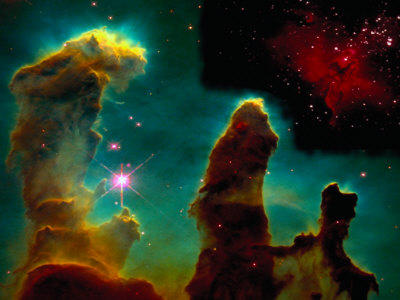No Star Shines Forever
All stars pass through stages defined as birth, life and death. Because
stars live for millions or billions of years, no one can observe the
entire life cycle of a star. Instead astronomers have constructed a
theory of stellar evolution consistent with the laws of physics and
supported by observations.
Stars are "born" out of gigantic interstellar clouds of gas and dust
called nebulae that exist in space. Recent observations with the Hubble Space
Telescope support this theory of star birth. The Eagle Nebula (M16) is a
prime example of a stellar nursery that is visible this time of the year
with the aid of a telescope.

Click Here for Information or to Buy this Print
The gas and dust in a nebula is eventually used up as more and more
stars are formed. What's left behind is a group of newly formed stars
(open star cluster) that drift apart over time (eg., Mel 111).
Most of a star's lifetime is spent shining bright. It gets its energy
from nuclear fusion reactions at its core. In the process four hydrogen
nuclei are fused into a single lighter helium nucleus. Energy is
produced that eventually reaches the star's surface to shine into space.
The amount of energy released by nuclear fusion can be calculated using
the famous equation by Albert Einstein, E=mc2 (where m is the mass lost
through fusion and c is the speed of light). Altair is an example of a
middle-aged star. Our Sun is another.
A star will shine bright until all the hydrogen at its core has been
converted to helium. Then it begins to die. Its outer layers will swell
to gigantic proportions, its surface temperature will drop, and its
color will turn red. The star has changed into a huge, bright, red star
known as a red giant. Antares is an example of a red supergiant star
that is currently visible in the sky.
After it has used up most of its fuel, a star like our Sun sheds off its
outer layer and begins to shrink. The material thrown off is called a
planetary nebula (eg., The Helix Nebula).
The collapsing star will eventually cool
into a dead star called a black dwarf. Very massive stars will end their
lives in a supernova explosion that will leave behind an extremely dense
object called a neutron star. Extremely massive stars will collapse even
further to form a black hole, an object so dense that its gravitational
pull prevents even light from escaping its surface!
Related Links:
Related Books:


